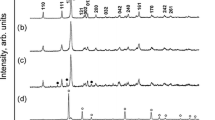Abstract
Scandium is a metal of value with increasing demand but limited supply. During the valorization of bauxite residue, scandium becomes concentrated in an NH4F strip liquor, from which it can be recovered as (NH4)3ScF6 by antisolvent crystallization. This study investigates the use of different antisolvents and their concentrations on the morphology and crystal size of the (NH4)3ScF6 crystals produced. The antisolvents include alcohols, ketones, and a sulfoxide. These were added all at once, either pure or diluted, to the aqueous solution to attain final concentration of 2, 4, or 8 mol/L total solution in separate experiments. Changes in the functional group and concentration of the antisolvents were observed to induce morphological and crystal size modifications of (NH4)3ScF6. The differences are likely due to the specific interactions of the antisolvent molecules with the atoms at the different faces of the crystals.
Access this chapter
Tax calculation will be finalised at checkout
Purchases are for personal use only
Similar content being viewed by others
References
U.S. Geological Survey (2021) Mineral commodity summaries 2021. Reston, Virginia
Duyvesteyn WPC, Putnam GF (2014) Scandium: a review of the element, its characteristics and current and emerging commercial applications. Nevada, EMC Metal Corporation White Paper
Krishnamurthy N, Gupta CK (2016) Extractive metallurgy of rare earths, 2nd edn. CRC Press Taylor and Francis Group, New York
Shaoquan X, Suqing L (1996) Review of the extractive metallurgy of scandium in China (1978–1991). Hydrometallurgy 42:337–343. https://doi.org/10.1016/0304-386X(95)00086-V
Wang W, Pranolo Y, Cheng CY (2011) Metallurgical processes for scandium recovery from various resources: a review. Hydrometallurgy 108:100–108. https://doi.org/10.1016/j.hydromet.2011.03.001
Liu Y, Naidu R (2014) Hidden values in bauxite residue (red mud): Recovery of metals. Waste Manag 34:2662–2673. https://doi.org/10.1016/j.wasman.2014.09.003
Liu Z, Li H (2015) Metallurgical process for valuable elements recovery from red mud—a review. Hydrometallurgy 155:29–43. https://doi.org/10.1016/j.hydromet.2015.03.018
Onghena B, Borra CR, van Gerven T, Binnemans K (2015) Selective recovery of scandium (III) from bauxite residue leachates by Sslvent extraction with a carboxyl-functionalised ionic liquid. In: Bauxite residue valorization and best practices. Leuven, pp 331–338
Harata M, Nakamura T, Yakushiji H, Okabe TH (2008) Production of scandium and Al–Sc alloy by metallothermic reduction. Miner Process Extr Metall 117:95–99. https://doi.org/10.1179/174328508X290876
Yagmurlu B, Zhang W, Avdibegovic D, et al (2018) Advances on scandium recovery beyond state of the art. In: ALTA 2018 uranium-REE-lithium proceedings. Perth, pp 85–93
Yagmurlu B, Dittrich C, Friedrich B (2018) Effect of aqueous media on the recovery of scandium by selective precipitation. Metals (Basel) 8:314. https://doi.org/10.3390/met8050314
Kaya Ş, Peters EM, Forsberg K et al (2018) Scandium recovery from an ammonium fluoride strip liquor by anti-solvent crystallization. Metals (Basel) 8:767. https://doi.org/10.3390/met8100767
Peters EM, Kaya Ş, Dittrich C, Forsberg K (2019) Recovery of scandium by crystallization techniques. J Sustain Metall 5:48–56. https://doi.org/10.1007/s40831-019-00210-4
Peters EM, Kaya Ş, Dittrich C, et al (2020) Recovery of alcohol after anti-solvent precipitation of (NH4)3ScF6 from NH4F strip liquors. In: XXX international mineral processing congress 2020. Cape Town
Haleblian JK (1975) Characterization of habits and crystalline modification of solids and their pharmaceutical applications. J Pharm Sci 64:1269–1288. https://doi.org/10.1002/jps.2600640805
Nokhodchi A, Bolourtchian N, Dinarvand R (2003) Crystal modification of phenytoin using different solvents and crystallization conditions. Int J Pharm 250:85–97. https://doi.org/10.1016/S0378-5173(02)00488-X
Tran TTD, Tran PHL, Park JB, Lee BJ (2012) Effects of solvents and crystallization conditions on the polymorphic behaviors and dissolution rates of valsartan. Arch Pharm Res 35:1223–1230. https://doi.org/10.1007/s12272-012-0713-7
Khamskii EV (1976) Some problems of crystal habit modification. In: Mullin JW (ed) Industrial crystallization. Plenum Press, New York
Zhou X, Shan J, Chen D, Li H (2019) Tuning the crystal habits of organic explosives by antisolvent crystallization: the case study of 2,6-dimaino-3,5-dinitropyrazine-1-oxid (LLM-105). Crystals 9:392. https://doi.org/10.3390/cryst9080392
Di Martino P, Censi R, Malaj L et al (2007) Influence of solvent and crystallization method on the crystal habit of metronidazole. Cryst Res Technol 42:800–806. https://doi.org/10.1002/crat.200710908
Larsen KL, Nielsen R, Do TT (2013) Production of channel type cyclodextrin crystals. US Patent Application No. 14/383,891
Nti-Gyabaah J, Gbewonyo K, Chiew YC (2010) Solubility of artemisinin in different single and binary solvent mixtures between (284.15 and 323.15) K and NRTL interaction parameters. J Chem Eng Data 55:3356–3363. https://doi.org/10.1021/je100125x
Abarca-Vargas R, Peña Malacara CF, Petricevich VL (2016) Characterization of chemical compounds with antioxidant and cytotoxic activities in bougainvillea x buttiana holttum and standl, (Var. rose) extracts. Antioxidants 5:45. https://doi.org/10.3390/antiox5040045
Gupta MN, Batra R, Tyagi R, Sharma A (1997) Polarity index: the guiding solvent parameter for enzyme stability in aqueous-organic cosolvent mixtures. Biotechnol Prog 13:284–288. https://doi.org/10.1021/bp9700263
Sudha C, Srinivasan K (2014) Understanding the effect of solvent polarity on the habit modification of monoclinic paracetamol in terms of molecular recognition at the solvent crystal/interface. Cryst Res Technol 49:865–872. https://doi.org/10.1002/crat.201400200
Boistelle R (1976) Survey of crystal modification in solution. In: Mullin JW (ed) Industrial crystallization. Plenum Press, New York
Gouthami KS, Kumar D, Thipparaboina R et al (2015) Can crystal engineering be as beneficial as micronisation and overcome its pitfalls?: A case study with cilostazol. Int J Pharm 491:26–34. https://doi.org/10.1016/j.ijpharm.2015.06.009
Peters EM, Svärd M, Forsberg K (2020) Phase equilibria of ammonium scandium fluoride phases in aqueous alcohol mixtures for metal recovery by anti-solvent crystallization. Sep Purif Technol 252:117449. https://doi.org/10.1016/j.seppur.2020.117449
Author information
Authors and Affiliations
Corresponding authors
Editor information
Editors and Affiliations
Rights and permissions
Copyright information
© 2022 The Minerals, Metals & Materials Society
About this paper
Cite this paper
Peters, E.M., Svärd, M., Forsberg, K. (2022). Effect of Antisolvent Type and Concentration on Morphology and Crystal Size of (NH4)3ScF6 Obtained by Antisolvent Crystallization. In: Ouchi, T., et al. Rare Metal Technology 2022. The Minerals, Metals & Materials Series. Springer, Cham. https://doi.org/10.1007/978-3-030-92662-5_12
Download citation
DOI: https://doi.org/10.1007/978-3-030-92662-5_12
Published:
Publisher Name: Springer, Cham
Print ISBN: 978-3-030-92661-8
Online ISBN: 978-3-030-92662-5
eBook Packages: Chemistry and Materials ScienceChemistry and Material Science (R0)




